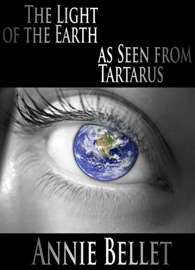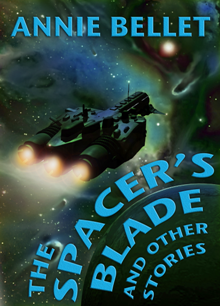This’ll likely be part 1 of this post, with more math and data to come later as I collect more.
Since multiple people have asked, both here in the comments and privately, I’ll show my numbers, so to speak.
I have two, yes just two, short stories up on Kindle/Smashwords etc. They are literary fiction and available for .99 cents. I put them up mostly to practice the formatting. A friend did my covers, which I think are beautiful. If you want to see the covers or check out the stories, follow this link.
First question people often wonder with self-publishing things is how do you know it’s any good. Well, I don’t. Good is fairly subjective because some people might like that kind of story, some might not. I do have some faith the writing in these stories is up to par because these are the two stories I used to get myself into an MFA program, so they can’t be bad on a writing level. But in the end, you never know. I would use the rough rule that if you have sold some fiction at pro or decent semi-pro rates and zines, if your submissions get more personal rejections than form letters, etc… as the measure for writing publishable/saleable fiction. And hey, not everyone will like what you write. Oh well. If you have readable writing, a decent grasp of story, a good cover, and a decent description/blurb, I don’t think you’ll suffer much in the e-pub market, from my experience.
So… to the math.
I’ve made about 8-9 dollars total over about 3 months with my stories (counting the one I had to take down because I accidentally sold it). This works out to each story averaging 1.16 per month for the two up now. One sells better (slightly) than the other, but it’s longer and the content less violent, so that doesn’t surprise me too much. I’ve also sold a few copies on Amazon UK netting me another 1.05.
Seems like nothing, doesn’t it? My two semi-pro sales this year got me 30 or so, my pro sale will be a heck of a lot more whenever it comes out (paid on publication for that one). But let’s look at the longer game here.
1.16 a month average per story (this will be my minimum, because this is the real number I’m getting now). I have two stories out. My goal is to write 40 short stories a year. (I’m at 21 this year, but I’ll catch up to near 40 by Jan, no worries). Give each story a year to two years to get through the pro/semi-pro markets on my list, so we’ll say that I get 20 stories up a year on average as the stories either sell (3 months average wait to get rights back) or sunset due to rejections/time.
So next year (we’ll call it year one) I might have 22 short stories e-pubbed by the end of the year (we’ll ignore putting together collections for the moment). At 1.16 a month each, that’s 25.52 dollars a month. Which would pay for my comic book habit, no problem.
Year two, another 20. But the first 20 have been earning as well, so now it’s 42 stories. That’s 48.72 a month. Or, another way to look at it, 584.64 a year. Sweet! I’m now (hypothetically, based on real numbers so far, of course) earning almost 600 a year extra for work I did years ago that I’ve also hopefully earned something on by selling to magazines.
Year three, another 20. So now we’re at 62 stories up online, each earning 1.16 a month. 71.92 a month. 863.04 a year. Anyway… you can see the progression. That trickle? It adds up. Not fast, but it builds and it sure as hell earns more than a story you’ve sold/didn’t sell/whatever would sitting on your hard drive.
Now, imagine if I wrote a story a week instead of just 40 a year (Bradbury does this, as do other pros). 52 stories a year. If I said screw it to trying to sell to magazines, I could put up 52 stories a year. That’s 60.32 a month, or 723.84 a year, the first year. Second year- 1,447.68. It just keeps going. But the really fun numbers are when you start to look at the total ten year earnings. So let’s do that.
On the 20 stories posted a year plan, after ten years I’d be earning about 2,800 a year in that tenth year from short stories. But over the course of those ten years, I’d have earned almost 14,500 from those stories total. Not that bad, especially when you think about it as work you did years and years ago, earning you thousands of dollars in a nice little trickle for you doing NOTHING. (And it is potentially all bonus money on top of any you made selling the story in the first place, because again, balance is key).
On the 52 short stories posted a year plan, the numbers, of course, look even sweeter in the long term. In that tenth year you’d earn about 7,240 from your short story inventory. Over the course of the whole ten years? You’d have earned about 37,000 from those short stories total. Again, not horrible.
This only works, of course, if you keep writing and learning and producing work. And I fully believe that if it takes you months to write a short story, this plan and method won’t work as well (though the trickle can still happen, and still build even at a pace like that).
Of course, if you want the math to get very insane, start making collections with those stories. At the end of plan 1 (20 posted a year), that’s enough for thirteen solid collections that you could sell at 2.99 or even 4.99 (12-15 stories each is pretty good, depending on story length). Thirteen 4.99 collections, selling just three copies a month each at 70% royalty rates (I don’t have real data for collections yet, of course, so this is now hypothetical time) would earn an extra 1,635 a year. For practically no extra work (after all, you have the stories already written and formatted, you just put them together. I’m guessing this would take at most an hour or two, plus time for a cover if you are doing your own).
I’m editing this to add the numbers for if you do collections off ten years of accruing 52 stories a year. This works out to about thirty five collections (12-15 stories per). Thirty five collections at 4.99 earning 70% royalties selling three copies a month each works out to about 4,400 a year. Again, for work you’ve already written, are already earning from (as separate short stories), and have to expend minimal effort on one more time to get into a collection.
Add it up. After ten years at the 20 story pace, you’re earning 4,435 a year off collections and shorts (370 a month) (and you will go on earning that on top of the 14,000+ you’ve already earned over the last decade). After ten years at the 52 story pace, you’re earning 11,600 a year off collections and shorts together (970 a month) and again, on top of the 37,000+ you’ve earned already over the last decade (see how it builds?).
So there you go. Some math, based on what I’m seeing over the last three months from my own very very limited experience. And I’m a no-name author. I’ve sold 3 short stories this year traditionally, but under a different name (Annie Bellet, my spec fic name) and in a different genre than the two posted online. I doubt I have any sort of platform or following at this point.
These are just my numbers and my take on things. I have no idea how well my e-pub novels will sell. That’s why I’m writing them (well, and the idea is kick-ass and will be a bucket of fun to write). I’m curious how this process and the numbers will stack up for a writer who is at this point pretty unknown. I’m going to do everything I can, of course, to make sure I fulfill the four principals hypothesized by Konrath and others about what makes an ebook sell (write a good book, low price point, good/professional cover, good blurb).
I intend to be open about my numbers when the time comes. I am very grateful to authors who have trod this path before me and put up their experiences and numbers, and I intend to pay that forward with my own data.
So, hopefully, this post answers some questions. Now, I’m going to write another short story, because without the work, these numbers mean nothing 🙂
*I did very rough math here. If I’ve made a mistake (I’m dyslexic, especially with numbers), I apologize. I triple checked, so hopefully I haven’t totally gone astray with my maths.



